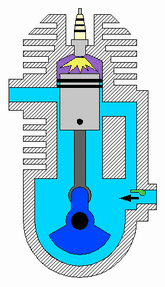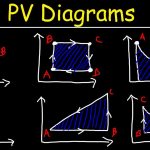Definition
As the name implies, the Two-stroke engines only require two piston movements (one cycle) in order to generate power. The engine is able to produce power after one cycle because the exhaust and intake of the gas occur simultaneously, as seen in Figure 1. There is a valve for the intake stroke that opens and closes due to changing pressures. In addition, due to its frequent contact with moving components, the fuel is mixed with oil to add lubrication, allowing smoother strokes.
Two-stroke engines processes:
- Compression stroke: The inlet port opens, the air-fuel mixture enters the chamber and the piston moves upwards compressing this mixture. A spark plug ignites the compressed fuel and begins the power stroke.
- Power stroke: The heated gas exerts high pressure on the piston, the piston moves downward (expansion), and waste heat is exhausted.

The thermal efficiency of these gasoline engines will vary depending on the model and design of the vehicle. However, in general, gasoline engines convert 20% of the fuel (chemical) energy to mechanical energy—in which only 15% will be used to move the wheels (the rest is lost to friction and other mechanical elements).
Compared to four-stroke engines, two strokes are lighter, more efficient, have the ability to use lower-grade fuel, and are more cost-efficient. Therefore, lighter engines result in a higher power-to-weight ratio (more power for less weight). However, they lack the maneuverability possible in four-stroke engines and require more lubrication. This makes two-stroke engines ideal for ships (need to carry a lot of cargo)[2], motorcycles, and lawnmowers—whereas a four-stroke would be ideal for automobiles like cars and trucks.
References:
- “File:Two-Stroke Engine.gif – Wikimedia Commons”, Commons.wikimedia.org, 2018. [Online]. Available: https://commons.wikimedia.org/wiki/File:Two-Stroke_Engine.gif.[Accessed: 17- May- 2018].
- ↑ Jump up to:2.0 2.1 2.2 E. Alturki, “Four-Stroke and Two-Stroke Marine Engines Comparison and Application”, International Journal of Engineering Research and Applications, vol. 07, no. 04, pp. 49-56, 2017.
- ↑ C. Wu, Thermodynamics and heat powered cycles. New York: Nova Science Publishers, 2007
- ↑ R. Wolfson, Energy, environment, and climate. New York: W.W. Norton & Company, 2012, p. 106.
- ↑ http://www.citethisforme.com
- ↑ Wikimedia Commons [Online], Available: https://en.wikipedia.org/wiki/Otto_cycle#/media/File:P-V_Otto_cycle.svg
- ↑ I. Dinçer and C. Zamfirescu, Advanced power generation systems. London, UK: Academic Press is an imprint of Elsevier, 2014, p. 266.
- For More Press Here









